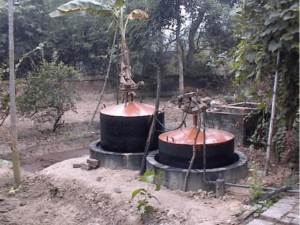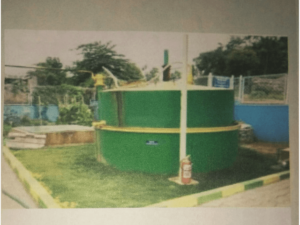
Gobar Gas is eco-friendly for the energy source. Gobar Gas converts cow dung and human excreta into biogas. This Gobar Gas also used for cooking and lighting. The gobar gas is established in farmhouses with buffalos. This is common in rural areas. The wastes from these units can be used for gardening.
Gobar Gas refers to produce gas from organic matter in the absence of oxygen. It is a renewable energy source, like solar energy and wind energy. Gobar Gas also available raw materials and recycled waste and are environmentally friendly and CO2 neutral. Gobar Gas is produced by the anaerobic digestion of biodegradable materials such as manure, municipal waste, sewage, plant material, green waste, and crops. Gobar Gas provide methane and carbon dioxide and may have small amounts of hydrogen sulfide. The gases methane, hydrogen, and carbon monoxide can be oxidized with oxygen. This energy allows Gobar Gas to be used as a fuel.
Benefits of Gobar Gas
- Can be used for cooking gas.
- For good waste management.
- Plant outcome can be used as a manure.
- Mosquito and Odour free.
- Low maintenance and portable.
- Suitable for home, hotels, fish market, etc.
- Available in different sizes.
- Can be installed over rooftop and garden.
- Suitable for both rural and urban areas.
Construction Process of Gobar Gas
First, a pit is dug, with the ten feet deep. Then a water-tight cement cylinder is constructed. Next, a wall is built across the middle, extending up from the bottom, not quite to the top. And outgo pipes are installed to it. The whole unit is water-tight. The manure is mixed with water in the Intake basin to make a slurry, then goes down the pipe to the bottom of the left side. This side of the cylinder gradually fills and overflows to the right side. Meanwhile, the whole mass bubbles methane up to the top. It collects under the large metal bell-like cover. The gas builds pressure and can be taken off through a rubber tube to a gas stove in a kitchen.
When both sides of the cylinder are full of manure, the effluent flows out from the bottom of the right side each time more raw manure is added to the left. What comes out on the right is of more value as fertilizer than the raw manure.
Uses of Gobar Gas
Generally, the uses of the gas can be as under
1) cooking
2) lighting
3) Motive Power a) run pump set b) half-cutter
4) can produce electricity.
Motive Power can be produced by linking the Gobar Gas to a dual fuel engine, specially designed for Gobar Gas.


